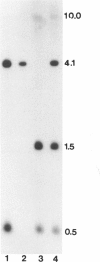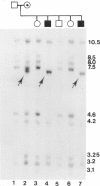Abstract
Of the approximately 170 families with X-linked muscular dystrophy of the Duchenne (DMD) and Becker (BMD) type in Finland, we have studied 90 unrelated patients for intragenic deletions by using the cDNA probes described by Koenig et al. Forty-five patients (50%) had molecular deletions of one or several of the 65 exon-containing HindIII fragments. In six deletion cases junction fragments of altered size were seen. Thirty-eight (84%) of the 45 deletions were detected using only two (1–2a and 8) of the six cDNA subclones. Using a wheelchair age of 12 years to distinguish between DMD and BMD, we found that the proportions of patients with deletions were similar. Deletions were equally common in familial and sporadic disease. BMD was more commonly caused by deletions in the 5' end of the gene than was DMD. In at least three instances deletions of similar type resulted in diseases of similar severity. Of 14 patients with mental retardation seven had deletions; six of these comprised exons contained in probe 8. We conclude that cDNA hybridization studies provide a powerful diagnostic tool in DMD and BMD and that they promise to produce better insights into molecular-clinical correlations.
Full text
PDF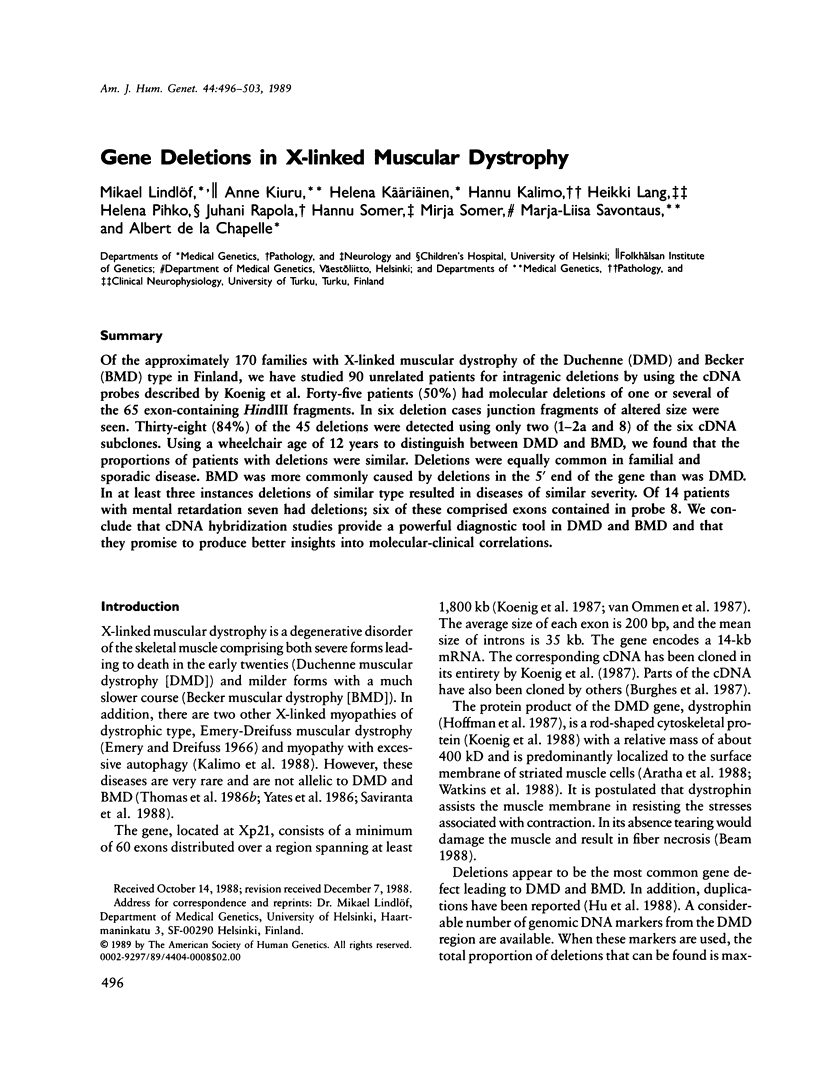
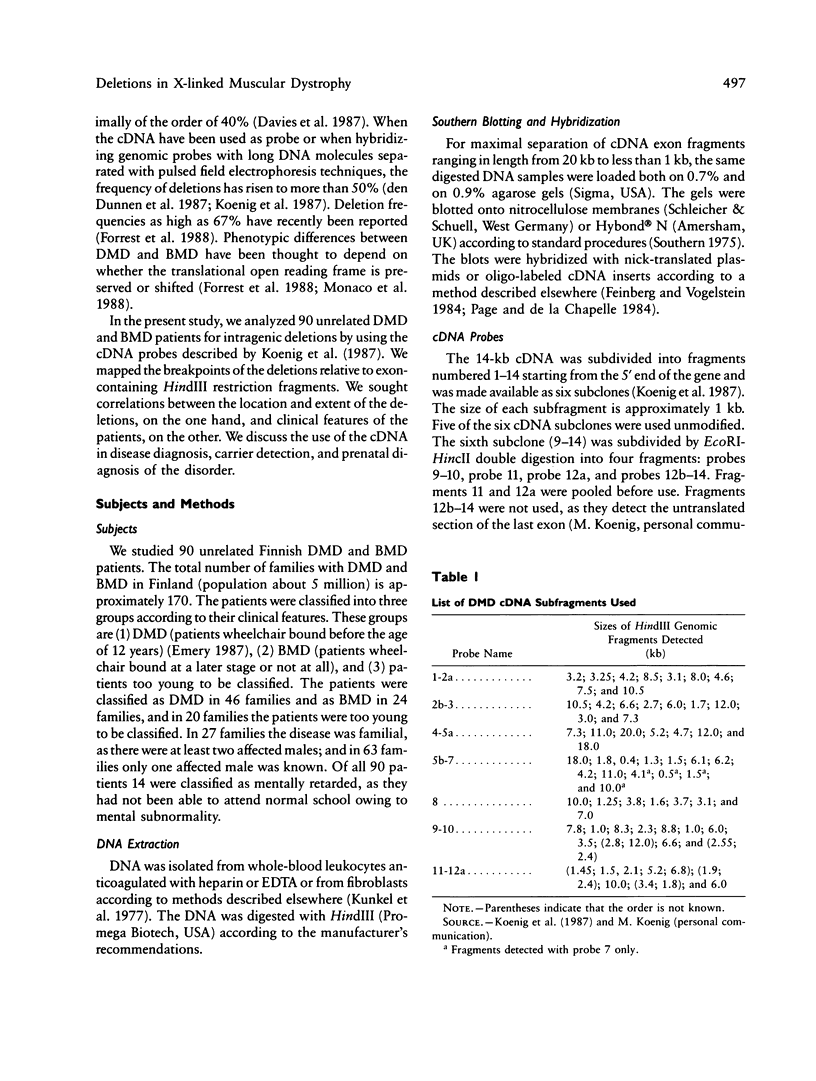
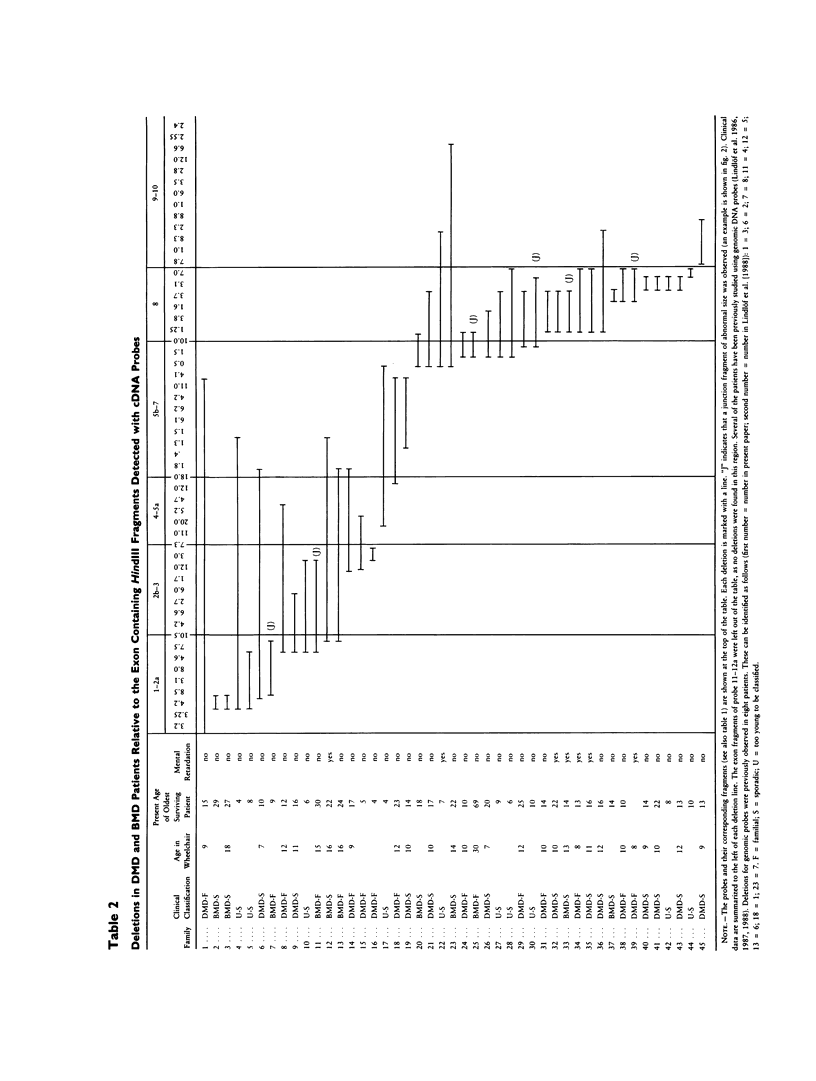
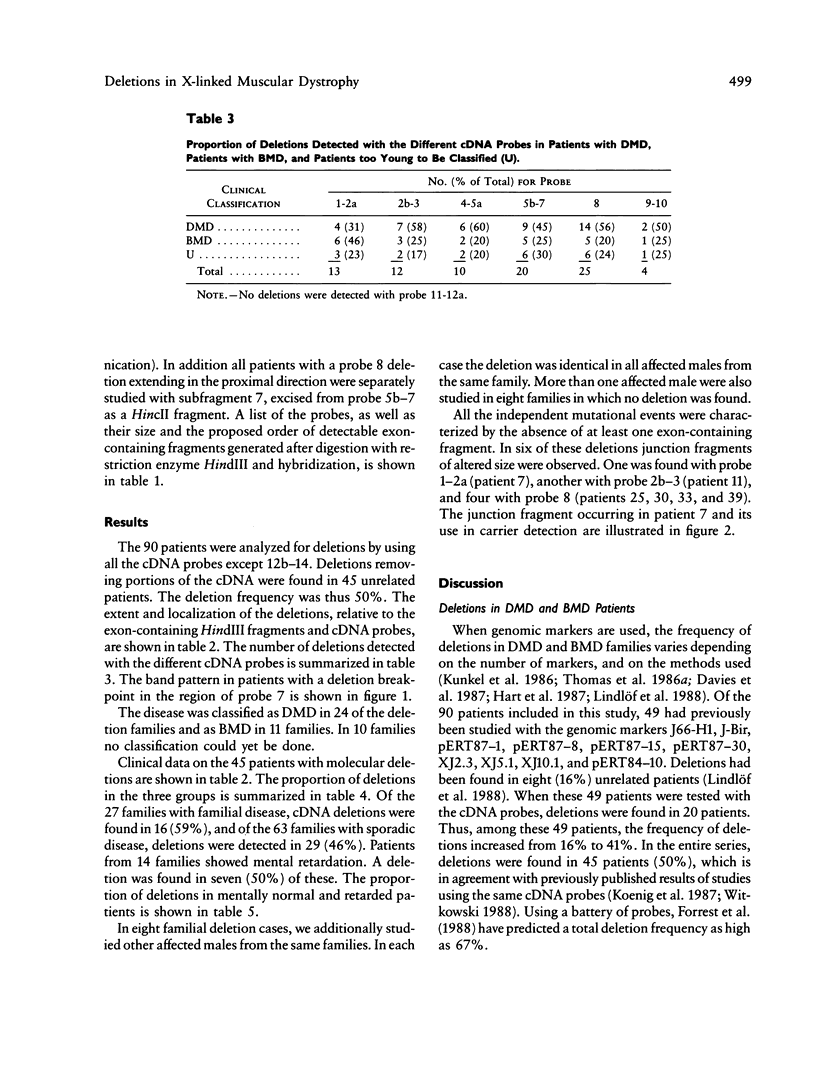
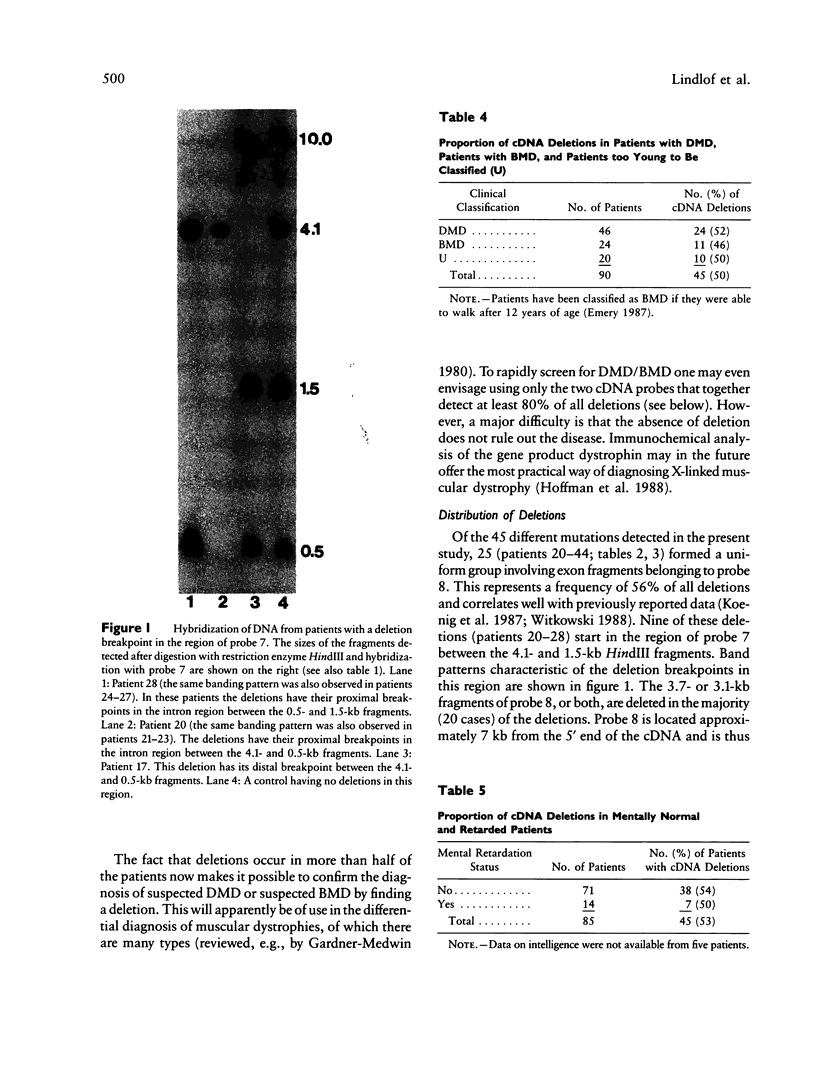
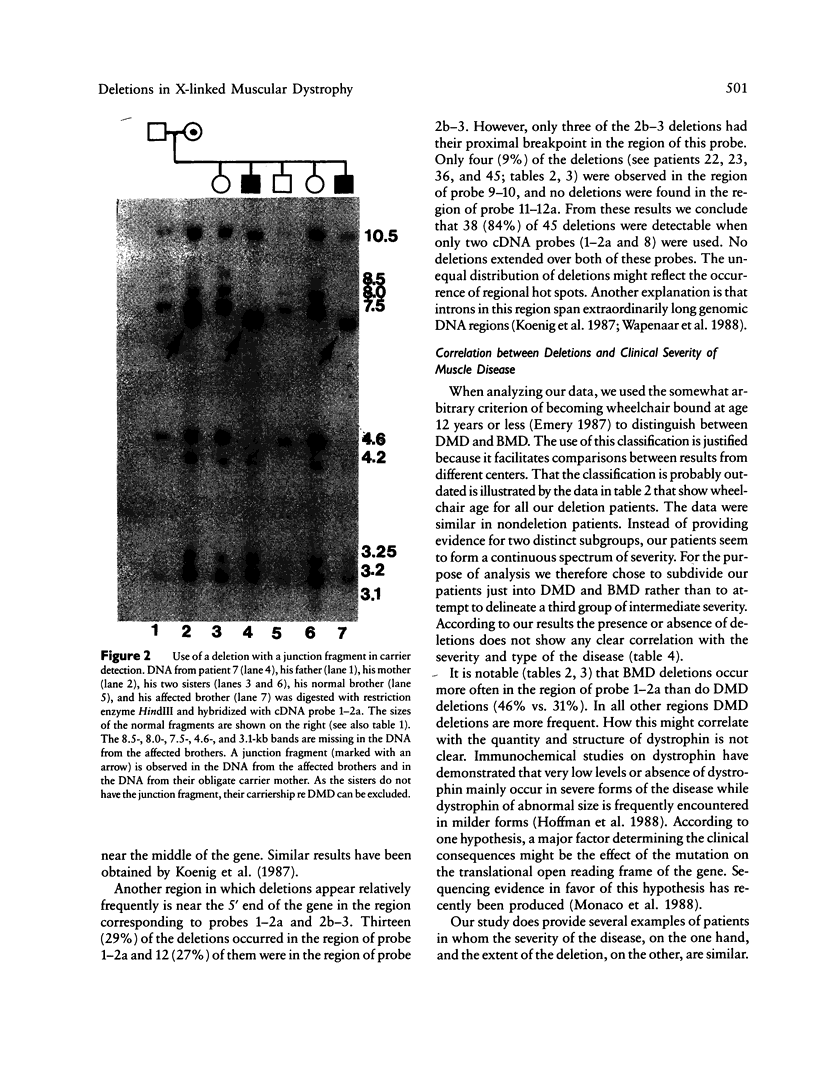
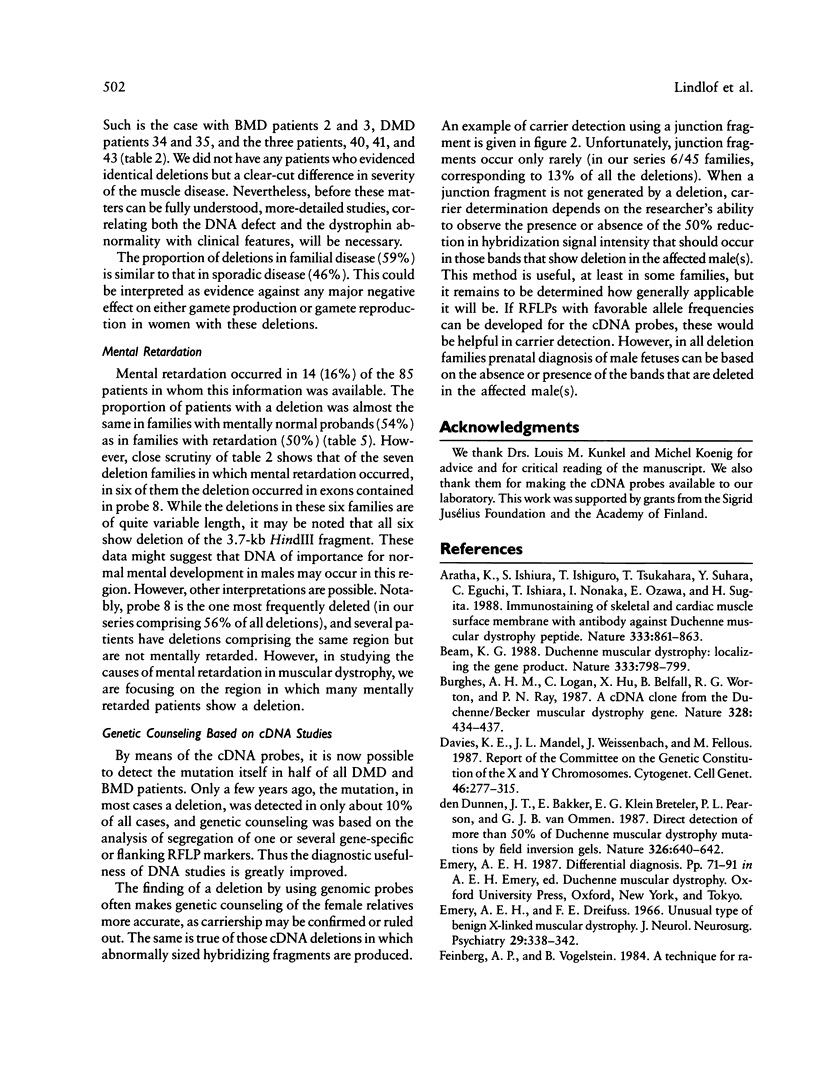
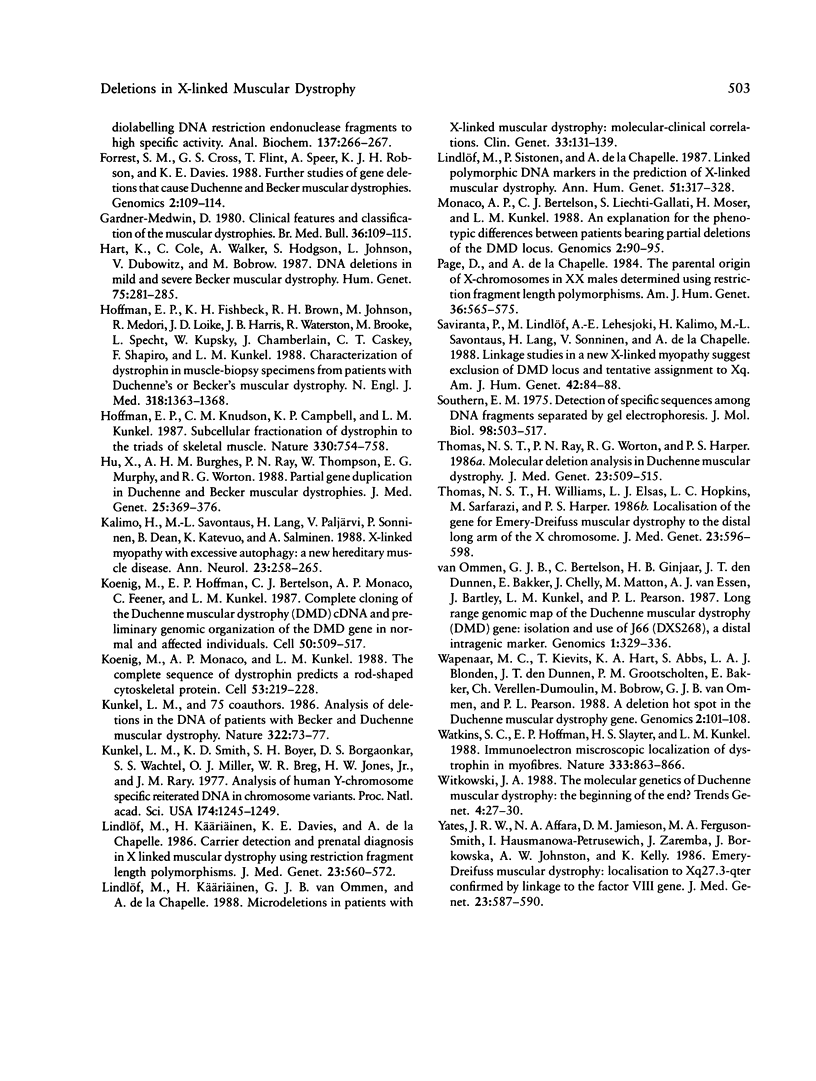
Images in this article
Selected References
These references are in PubMed. This may not be the complete list of references from this article.
- Arahata K., Ishiura S., Ishiguro T., Tsukahara T., Suhara Y., Eguchi C., Ishihara T., Nonaka I., Ozawa E., Sugita H. Immunostaining of skeletal and cardiac muscle surface membrane with antibody against Duchenne muscular dystrophy peptide. Nature. 1988 Jun 30;333(6176):861–863. doi: 10.1038/333861a0. [DOI] [PubMed] [Google Scholar]
- Beam K. G. Duchenne muscular dystrophy. Localizing the gene product. Nature. 1988 Jun 30;333(6176):798–799. doi: 10.1038/333798a0. [DOI] [PubMed] [Google Scholar]
- Burghes A. H., Logan C., Hu X., Belfall B., Worton R. G., Ray P. N. A cDNA clone from the Duchenne/Becker muscular dystrophy gene. 1987 Jul 30-Aug 5Nature. 328(6129):434–437. doi: 10.1038/328434a0. [DOI] [PubMed] [Google Scholar]
- Davies K. E., Mandel J. L., Weissenbach J., Fellous M. Report of the committee on the genetic constitution of the X and Y chromosomes. Cytogenet Cell Genet. 1987;46(1-4):277–315. doi: 10.1159/000132481. [DOI] [PubMed] [Google Scholar]
- Emery A. E., Dreifuss F. E. Unusual type of benign x-linked muscular dystrophy. J Neurol Neurosurg Psychiatry. 1966 Aug;29(4):338–342. doi: 10.1136/jnnp.29.4.338. [DOI] [PMC free article] [PubMed] [Google Scholar]
- Feinberg A. P., Vogelstein B. "A technique for radiolabeling DNA restriction endonuclease fragments to high specific activity". Addendum. Anal Biochem. 1984 Feb;137(1):266–267. doi: 10.1016/0003-2697(84)90381-6. [DOI] [PubMed] [Google Scholar]
- Forrest S. M., Cross G. S., Flint T., Speer A., Robson K. J., Davies K. E. Further studies of gene deletions that cause Duchenne and Becker muscular dystrophies. Genomics. 1988 Feb;2(2):109–114. doi: 10.1016/0888-7543(88)90091-2. [DOI] [PubMed] [Google Scholar]
- Gardner-Medwin D. Clinical features and classification of the muscular dystrophies. Br Med Bull. 1980 May;36(2):109–115. doi: 10.1093/oxfordjournals.bmb.a071623. [DOI] [PubMed] [Google Scholar]
- Hart K. A., Hodgson S., Walker A., Cole C. G., Johnson L., Dubowitz V., Bobrow M. DNA deletions in mild and severe Becker muscular dystrophy. Hum Genet. 1987 Mar;75(3):281–285. doi: 10.1007/BF00281075. [DOI] [PubMed] [Google Scholar]
- Hoffman E. P., Fischbeck K. H., Brown R. H., Johnson M., Medori R., Loike J. D., Harris J. B., Waterston R., Brooke M., Specht L. Characterization of dystrophin in muscle-biopsy specimens from patients with Duchenne's or Becker's muscular dystrophy. N Engl J Med. 1988 May 26;318(21):1363–1368. doi: 10.1056/NEJM198805263182104. [DOI] [PubMed] [Google Scholar]
- Hoffman E. P., Knudson C. M., Campbell K. P., Kunkel L. M. Subcellular fractionation of dystrophin to the triads of skeletal muscle. Nature. 1987 Dec 24;330(6150):754–758. doi: 10.1038/330754a0. [DOI] [PubMed] [Google Scholar]
- Hu X. Y., Burghes A. H., Ray P. N., Thompson M. W., Murphy E. G., Worton R. G. Partial gene duplication in Duchenne and Becker muscular dystrophies. J Med Genet. 1988 Jun;25(6):369–376. doi: 10.1136/jmg.25.6.369. [DOI] [PMC free article] [PubMed] [Google Scholar]
- Kalimo H., Savontaus M. L., Lang H., Paljärvi L., Sonninen V., Dean P. B., Katevuo K., Salminen A. X-linked myopathy with excessive autophagy: a new hereditary muscle disease. Ann Neurol. 1988 Mar;23(3):258–265. doi: 10.1002/ana.410230308. [DOI] [PubMed] [Google Scholar]
- Koenig M., Hoffman E. P., Bertelson C. J., Monaco A. P., Feener C., Kunkel L. M. Complete cloning of the Duchenne muscular dystrophy (DMD) cDNA and preliminary genomic organization of the DMD gene in normal and affected individuals. Cell. 1987 Jul 31;50(3):509–517. doi: 10.1016/0092-8674(87)90504-6. [DOI] [PubMed] [Google Scholar]
- Koenig M., Monaco A. P., Kunkel L. M. The complete sequence of dystrophin predicts a rod-shaped cytoskeletal protein. Cell. 1988 Apr 22;53(2):219–228. doi: 10.1016/0092-8674(88)90383-2. [DOI] [PubMed] [Google Scholar]
- Kunkel L. M., Hejtmancik J. F., Caskey C. T., Speer A., Monaco A. P., Middlesworth W., Colletti C. A., Bertelson C., Müller U., Bresnan M. Analysis of deletions in DNA from patients with Becker and Duchenne muscular dystrophy. Nature. 1986 Jul 3;322(6074):73–77. doi: 10.1038/322073a0. [DOI] [PubMed] [Google Scholar]
- Kunkel L. M., Smith K. D., Boyer S. H., Borgaonkar D. S., Wachtel S. S., Miller O. J., Breg W. R., Jones H. W., Jr, Rary J. M. Analysis of human Y-chromosome-specific reiterated DNA in chromosome variants. Proc Natl Acad Sci U S A. 1977 Mar;74(3):1245–1249. doi: 10.1073/pnas.74.3.1245. [DOI] [PMC free article] [PubMed] [Google Scholar]
- Lindlöf M., Käriäinen H., Davies K. E., de la Chapelle A. Carrier detection and prenatal diagnosis in X linked muscular dystrophy using restriction fragment length polymorphisms. J Med Genet. 1986 Dec;23(6):560–572. doi: 10.1136/jmg.23.6.560. [DOI] [PMC free article] [PubMed] [Google Scholar]
- Lindlöf M., Käriäinen H., van Ommen G. J., de la Chapelle A. Microdeletions in patients with X-linked muscular dystrophy: molecular-clinical correlations. Clin Genet. 1988 Feb;33(2):131–139. doi: 10.1111/j.1399-0004.1988.tb03424.x. [DOI] [PubMed] [Google Scholar]
- Lindlöf M., Sistonen P., de la Chapelle A. Linked polymorphic DNA markers in the prediction of X-linked muscular dystrophy. Ann Hum Genet. 1987 Oct;51(Pt 4):317–328. doi: 10.1111/j.1469-1809.1987.tb01066.x. [DOI] [PubMed] [Google Scholar]
- Monaco A. P., Bertelson C. J., Liechti-Gallati S., Moser H., Kunkel L. M. An explanation for the phenotypic differences between patients bearing partial deletions of the DMD locus. Genomics. 1988 Jan;2(1):90–95. doi: 10.1016/0888-7543(88)90113-9. [DOI] [PubMed] [Google Scholar]
- Page D. C., de la Chapelle A. The parental origin of X chromosomes in XX males determined using restriction fragment length polymorphisms. Am J Hum Genet. 1984 May;36(3):565–575. [PMC free article] [PubMed] [Google Scholar]
- Saviranta P., Lindlöf M., Lehesjoki A. E., Kalimo H., Lang H., Sonninen V., Savontaus M. L., de la Chapelle A. Linkage studies in a new X-linked myopathy, suggesting exclusion of DMD locus and tentative assignment to distal Xq. Am J Hum Genet. 1988 Jan;42(1):84–88. [PMC free article] [PubMed] [Google Scholar]
- Southern E. M. Detection of specific sequences among DNA fragments separated by gel electrophoresis. J Mol Biol. 1975 Nov 5;98(3):503–517. doi: 10.1016/s0022-2836(75)80083-0. [DOI] [PubMed] [Google Scholar]
- Thomas N. S., Ray P. N., Worton R. G., Harper P. S. Molecular deletion analysis in Duchenne muscular dystrophy. J Med Genet. 1986 Dec;23(6):509–515. doi: 10.1136/jmg.23.6.509. [DOI] [PMC free article] [PubMed] [Google Scholar]
- Thomas N. S., Williams H., Elsas L. J., Hopkins L. C., Sarfarazi M., Harper P. S. Localisation of the gene for Emery-Dreifuss muscular dystrophy to the distal long arm of the X chromosome. J Med Genet. 1986 Dec;23(6):596–598. doi: 10.1136/jmg.23.6.596. [DOI] [PMC free article] [PubMed] [Google Scholar]
- Wapenaar M. C., Kievits T., Hart K. A., Abbs S., Blonden L. A., den Dunnen J. T., Grootscholten P. M., Bakker E., Verellen-Dumoulin C., Bobrow M. A deletion hot spot in the Duchenne muscular dystrophy gene. Genomics. 1988 Feb;2(2):101–108. doi: 10.1016/0888-7543(88)90090-0. [DOI] [PubMed] [Google Scholar]
- Watkins S. C., Hoffman E. P., Slayter H. S., Kunkel L. M. Immunoelectron microscopic localization of dystrophin in myofibres. Nature. 1988 Jun 30;333(6176):863–866. doi: 10.1038/333863a0. [DOI] [PubMed] [Google Scholar]
- Witkowski J. A. The molecular genetics of Duchenne muscular dystrophy: the beginning of the end? Trends Genet. 1988 Feb;4(2):27–30. doi: 10.1016/0168-9525(88)90060-1. [DOI] [PubMed] [Google Scholar]
- Yates J. R., Affara N. A., Jamieson D. M., Ferguson-Smith M. A., Hausmanowa-Petrusewicz I., Zaremba J., Borkowska J., Johnston A. W., Kelly K. Emery-Dreifuss muscular dystrophy: localisation to Xq27.3----qter confirmed by linkage to the factor VIII gene. J Med Genet. 1986 Dec;23(6):587–590. doi: 10.1136/jmg.23.6.587. [DOI] [PMC free article] [PubMed] [Google Scholar]
- van Ommen G. J., Bertelson C., Ginjaar H. B., den Dunnen J. T., Bakker E., Chelly J., Matton M., van Essen A. J., Bartley J., Kunkel L. M. Long-range genomic map of the Duchenne muscular dystrophy (DMD) gene: isolation and use of J66 (DXS268), a distal intragenic marker. Genomics. 1987 Dec;1(4):329–336. doi: 10.1016/0888-7543(87)90032-2. [DOI] [PubMed] [Google Scholar]



